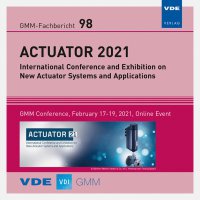Modeling and simulation of compliant biasing systems for dielectric elastomer membranes based on polymeric domes
Conference: ACTUATOR - International Conference and Exhibition on New Actuator Systems and Applications 2021
02/17/2021 - 02/19/2021 at Online
Proceedings: GMM-Fb. 98: ACTUATOR 2021
Pages: 4Language: englishTyp: PDF
Authors:
Croce, Sipontina; Neu, Julian; Rizzello, Gianluca (Intelligent Material Systems Lab, Department of Systems Engineering, Department of Materials Science and Engineering, Saarland University, Saarbruecken, Germany)
Hubertus, Jonas; Schultes, Guenter (University of Applied Sciences of Saarland, Department of Sensors and Thin Films, Saarbrücken, Germany)
Seelecke, Stefan (Intelligent Material Systems Lab, Department of Systems Engineering, Department of Materials Science and Engineering, Saarland University, Saarbruecken, Germany & Guenter)
Abstract:
Due to their large deformation, high flexibility, and lightweight, dielectric elastomer actuators (DEAs) represent a promising alternative technology for the design of miniaturized drive systems. In order to generate a stroke, a membrane DEA needs to be preloaded with a mechanical bias elements. The use of negative-rate biasing systems (NBS), such as buckled beams or permanent magnets, permits to significantly increase the resulting DEA stroke in comparison to conventional linear springs. This paper focuses on a novel type of NBS element for DEAs, consisting of compliant polymer domes. Advantages of the compliant domes over a rigid NBS include large mechanical flexibility in conjunction with high potential for miniaturization. A physics-based model of the dome is first developed and implemented in a finite element simulation environment. The model is subsequently calibrated and validated via experimental data. A design algorithm is finally developed to determine the biasing system geometry which maximizes the actuator stroke, based on the knowledge of the dome material parameters as well as the electro-mechanical DEA characteristics.


